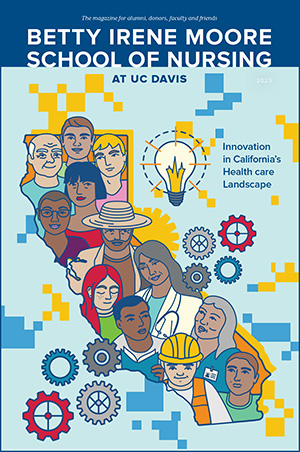Alumni distinction
Doctoral graduate investigates correlation between activity and achievement in Latino communities

Lisa Martinez
Disparities in health care are often a result of environmental conditions, social and economic factors, insufficient health resources and poor disease management. That reality, coupled with a report by the U.S. Department of Health and Human Resources that found Mexican Americans are experiencing a sharp rise in the prevalence of type 2 diabetes, motivated Lisa Martinez. The recent graduate of the Doctor of Philosophy in Nursing Science and Health-Care Leadership Graduate Degree Program at the Betty Irene Moore School of Nursing at UC Davis turned her attention to prevention, examining obesity and education in low-income, Mexican heritage, elementary school children. Her research has the potential to influence health and education policy to promote life-long health and well-being in this previously unstudied demographic.
“At the end of the day when I came home from a shift on the telemetry unit, I wanted to do more for all the people I saw suffering from chronic diseases,” Martinez, a registered nurse, said. “I knew I needed to focus on prevention, and children are the best group of people to instill good health practices early in life.”
Martinez partnered with the UC Davis Center for Transnational Health and its Ninos Sanos, Familia Sana project, which targets childhood obesity through nutrition, physical activity, economic and community-based interventions in California’s Central Valley. While the five-year study involved more than 600 children ages 2 to 8, Martinez focused on a smaller group of children looking specifically at how their physical activity related to their academic achievement.
“I discovered that while they were obese, these children were very active,” Martinez explained. “So while my small, sample size did not produce anything significant in the link between academic performance and physical activity, it indicated we need to focus more on nutrition and the maintenance of these high levels of physical activity as the children get older in this community.”
Type 2 diabetes disproportionately affects Hispanics and Latinos. Nearly 8.5 percent of Hispanics have diabetes, compared to just over 1 percent for non-Hispanic whites. Additionally, living in substandard housing or in low-income neighborhoods results in higher rates of obesity due to lack of healthy food options and opportunities for safe physical activity. Rather than simply identify the problems from collected data, Martinez and her colleagues sought input from residents within those low-income, immigrant Latino communities, which have been understudied in the past.
“This study was such an integral part of my education because it focused on a community-based approach and placed me in a team of collaborators,” Martinez said. “The School of Nursing focuses on interdisciplinary learning, innovation and teamwork. With chronic diseases, you must work with a team and create out-of-the-box solutions because there are so many contributing factors. Therefore, many solutions are needed and they vary depending on the target population.”
Her research expands our understanding of how physical activity affects learning, highlighting the need for innovative health and education policies that expand access to exercise and acknowledge its correlation with academic achievement. Having completed the program, Martinez works as a postdoctoral scholar for Ninos Sanos, Familia Sana to further understand health disparities, childhood obesity and how to prevent chronic diseases.





